New Directions In Sex Therapy: Innovations And Alternatives Download Pdf
In the fight against serious diseases and ailments, scientists oftentimes resort to the use of innovative technologies. As a result, how-do-you-do-tech simulators have come to replace traditional therapy. If earlier many diseases and diagnoses sounded like a verdict, nowadays, the apply of modern technologies gives patients promise for fractional or even consummate recovery.
Back in the early nineties, scientists began to master VR technology in medicine. Medical VR apps started to announced most twenty years agone and included surgical simulators, rehabilitation applications, and telepresence surgery solutions in VR. One of the first VR simulators designed back in 1991 was The Greenish Telepresence Surgery System, which consisted of two units, the workstation for surgeons, and the remote worksite. Using such VR simulators, people could practice surgery with a scalpel and clamps, just on a virtual trunk. Information technology was a huge step forrad in medical education and capacity-building for surgeons.
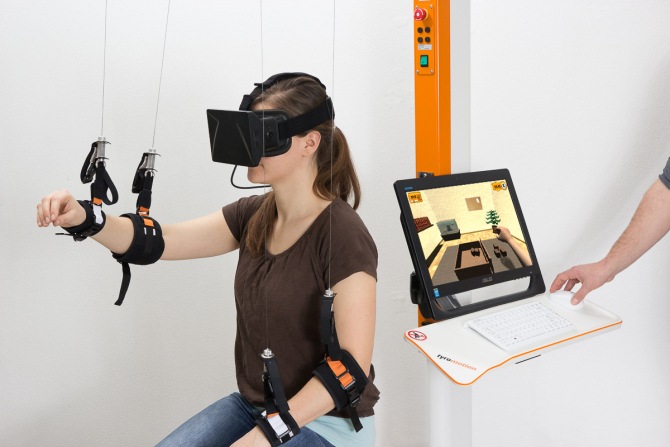
At present, when virtual reality is rightly considered an integral part of many spheres of human life, medicine has non become an exception, and numerous studies in this direction are a confirmation to that. According to the enquiry conducted by Research and Markets, the value of the virtual and augmented reality marketplace in healthcare will reach $5 billion by 2023. Experts believe that virtual and augmented reality technologies volition be widely used for handling and rehabilitation purposes, diagnostics, and remote consultation of patients.
This research studies how virtual reality tin can be used in the rehabilitation of seriously sick patients. Besides, we'll check some existing and potential applications for this technology in the field of inability and rehabilitation for the ease of reference.
Why to Utilise VR in Healthcare?
Today, Virtual Reality in medicine is nothing new, and in that location are more and more medical fields where the use of VR applications shows much meliorate results compared with conventional therapy. The utilise of VR in rehabilitation has proved to be very constructive, and for a proficient reason. Simulated virtual objects, environment, and events allow patients to plunge into an alternate reality, where they tin can interact with things and comport out actions non otherwise available to them in real life. This is 1 of the very few, if non the but, means to let patients "escape" from the restrictive hospital environment.
Moreover, VR in rehabilitation:
- allows patients with different disorders to execute actions that they cannot perform in real life due to their disabilities;
- gives an opportunity to use more advanced digital rehabilitation methods as an alternative to traditional therapy, thus maximizing the consequence of the rehabilitation measures;
- can be used in individualized handling plans developed on the basis of careful assessment and post-obit case-by-case handling goals;
- helps clarify and better understand the needs of people with disabilities in public places and at home.
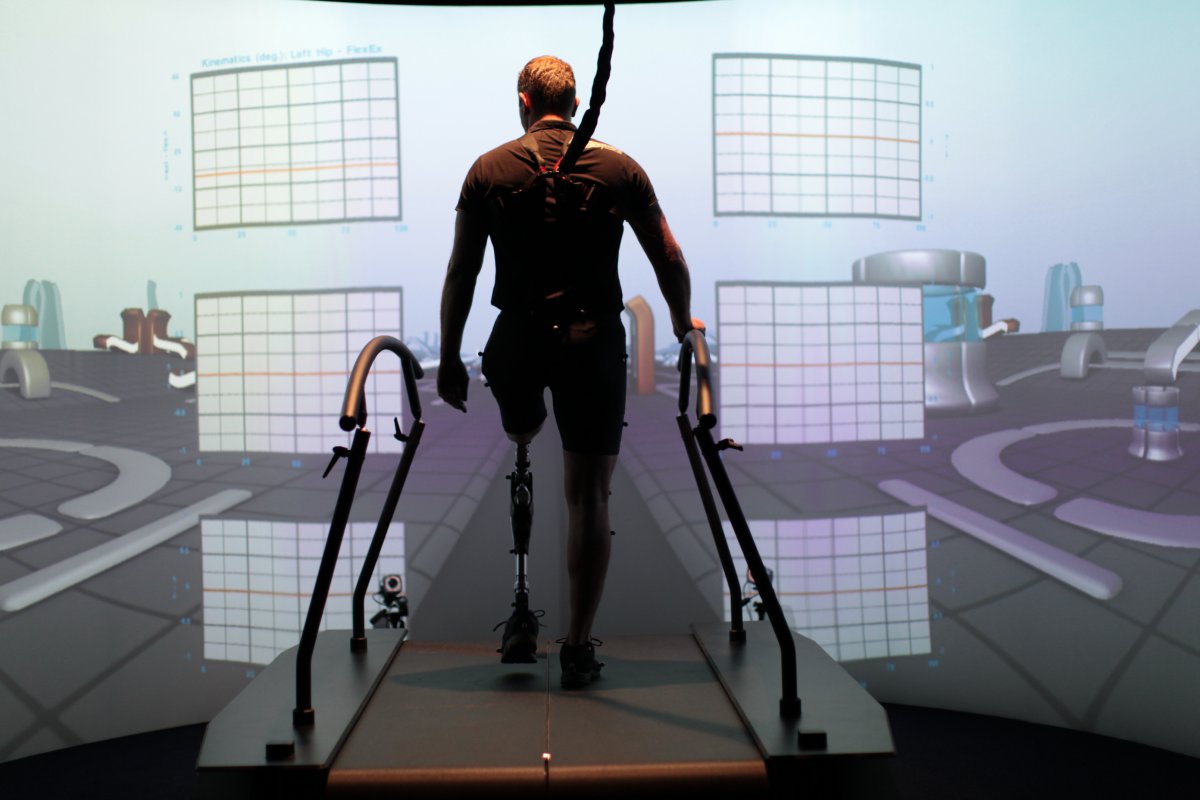
And then, why is Virtual Reality ideal for rehabilitation?
In order to restore functions, the rehabilitation process should see the following requirements:
- A patient should train in an environment that is as close as possible to the existent globe.
- A patient should be provided with timely feedback on the progress and quality of tasks he or she performs, and so that he has the opportunity to empathise and correct possible mistakes and redo the practice every bit many times as possible until he succeeds.
- A patient should exist engaged in the process and willing to be trained.
Using traditional methods, for example, therapeutic gymnastics, it is not always possible to follow all requirements, in contrast to VR. Virtual reality, with its capabilities to simulate practically any environs, the ability to provide fast and elaborate feedback along with highly motivational game-like tasks is able to fill up the missing components of a successful rehabilitation programme.
Virtual reality is a new mode of rehabilitation through entertainment. It guarantees maximum interest in the process promoting and encouraging patients to participate in treatment for maximum results.
Neurological Damages: VR Rehabilitation of Brain Injury and Stroke Survivors
Every yr, more than fifteen million people suffer a stroke and only a few of them manage to render to normal life later on. The reason is obvious: stroke victims crave a long and complex rehabilitation to be able to control their movements once again and return to normal action.
VR opens a broad field for the development of new rehabilitation methods for stroke and other brain injury survivors. VR affects involuntary movements produced automatically and on a subconscious level. Sensory stimuli of virtual reality crusade muscle contractions and are constructive in training residue, proprioception, and, especially, in restoring the paralyzed side of patients who have suffered a stroke.
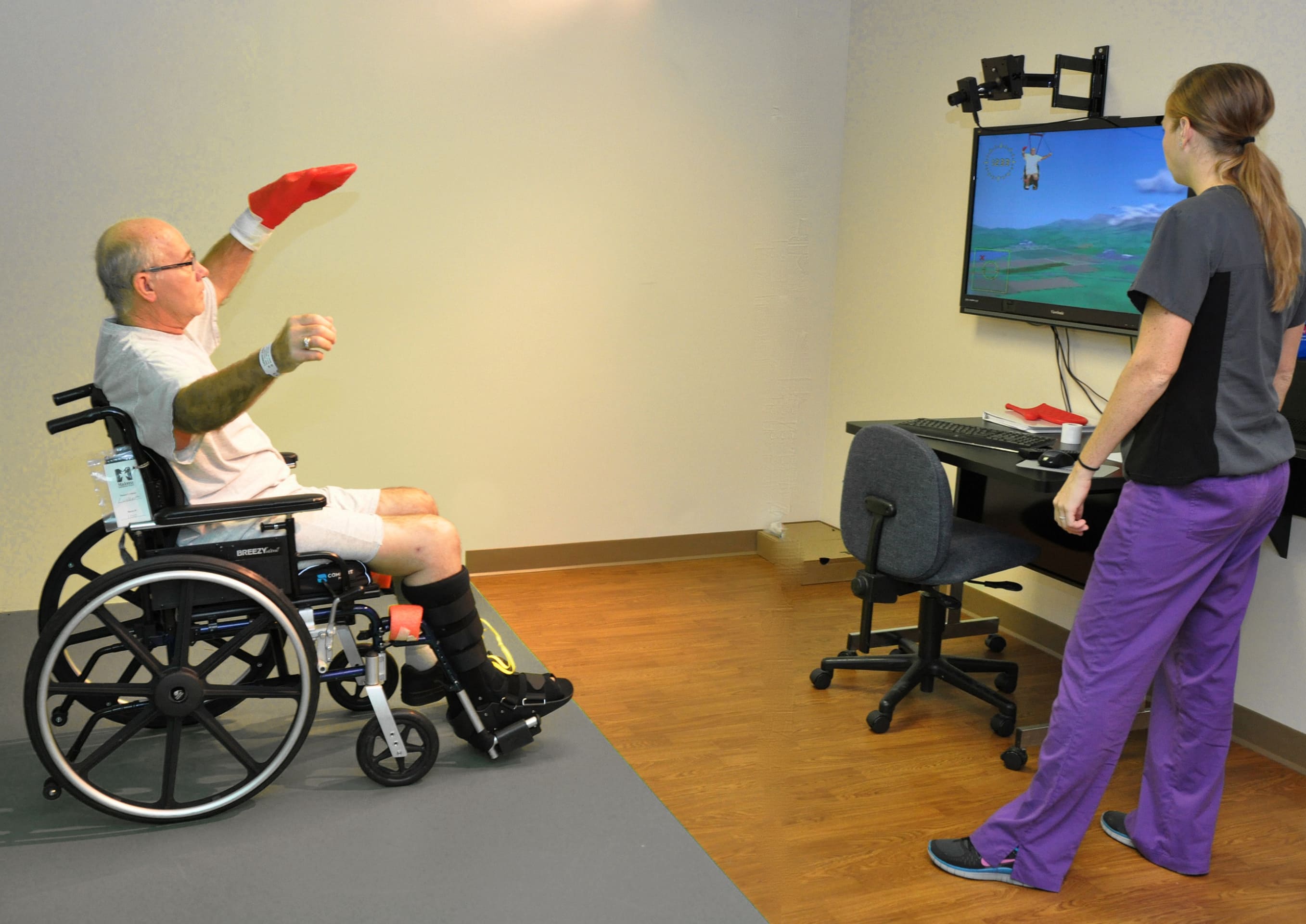
Rehabilitation programs that utilise virtual reality for recovery later on a stroke demonstrate splendid results, improved psychological state, and increased motivation of patients. Here are some VR solutions that demonstrate an innovative and individual arroyo to the rehabilitation of encephalon injury and stroke victims.
IREX is an upper and lower-extremity practise VR solution that uses video gesture control technology. The system helps patients restore multiple concrete functions including balance, rotation, crouching, fine motor control, and others. The rehabilitation sessions are organized in class of a VR game resulting in a higher motivation of participants. Early on studies of the IREX system showed that patients were upwardly to three times more excited about rehabilitation with IREX compared to traditional rehabilitation procedures and were willing to repeat the sessions ii or even three times in a row.
Restoration of Hand Motor Functions with VR
The consequences of circulatory diseases may seriously affect the quality of life of patients. The technology of virtual reality is likewise successfully used to restore the motor function of the upper limbs. 1 of the most important tasks in rehabilitation is to restore the bones motor skills of the hands, such every bit:
- ability to achieve an object;
- manipulate information technology;
- coordinate the movements of both hands.
There are unlike causes of such disorders, but, primarily, they include muscle weakness and changes in the coordination of joint movements. Despite the fact that traditional physical rehabilitation of motor functions of hands can hardly exist replaced by virtual therapy, some positive experiences of using the latter have already been accumulated. Though virtual reality has non plant wide application in upper limb rehabilitation, multiple research in this domain indicate the greater efficiency of VR grooming compared with conventional rehabilitation, and some pioneering 3D solutions in this domain have been successfully adopted by United states and European hospitals.
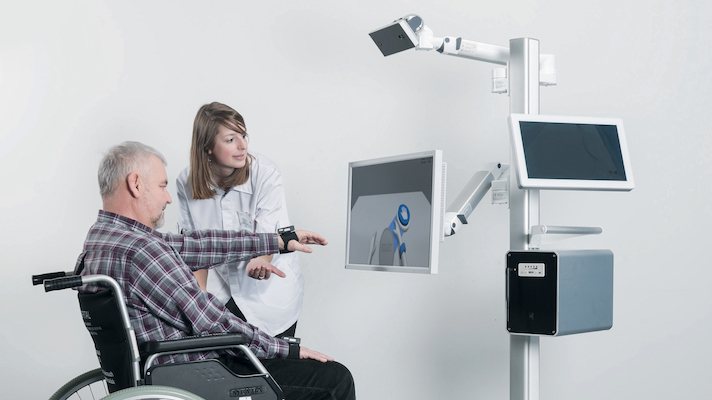
MindMotionPRO is a next-gen VR therapy organisation developed by a Swiss kickoff-up MindMaze in close cooperation with neurorehabilitation experts. This organisation is used equally an aid to restoring upper limb motor function as early every bit 1-6 weeks post stroke. The main benefits of this 3D solution include:
- enhancement of patient's motivation with 3D virtual environments,
- firsthand and illustrative feedback,
- improved outcomes through neurophysiological measurements & assay.
MindMotion PRO has been adult over a decade by the neuroscientists and experts in VR and AR in Switzerland.
Restoring Posture and Balance with the Help of Virtual Reality
Virtual reality is widely used to rehabilitate patients with neurological disorders, particularly to restore postural stability of patients with various forms of postural insufficiency .
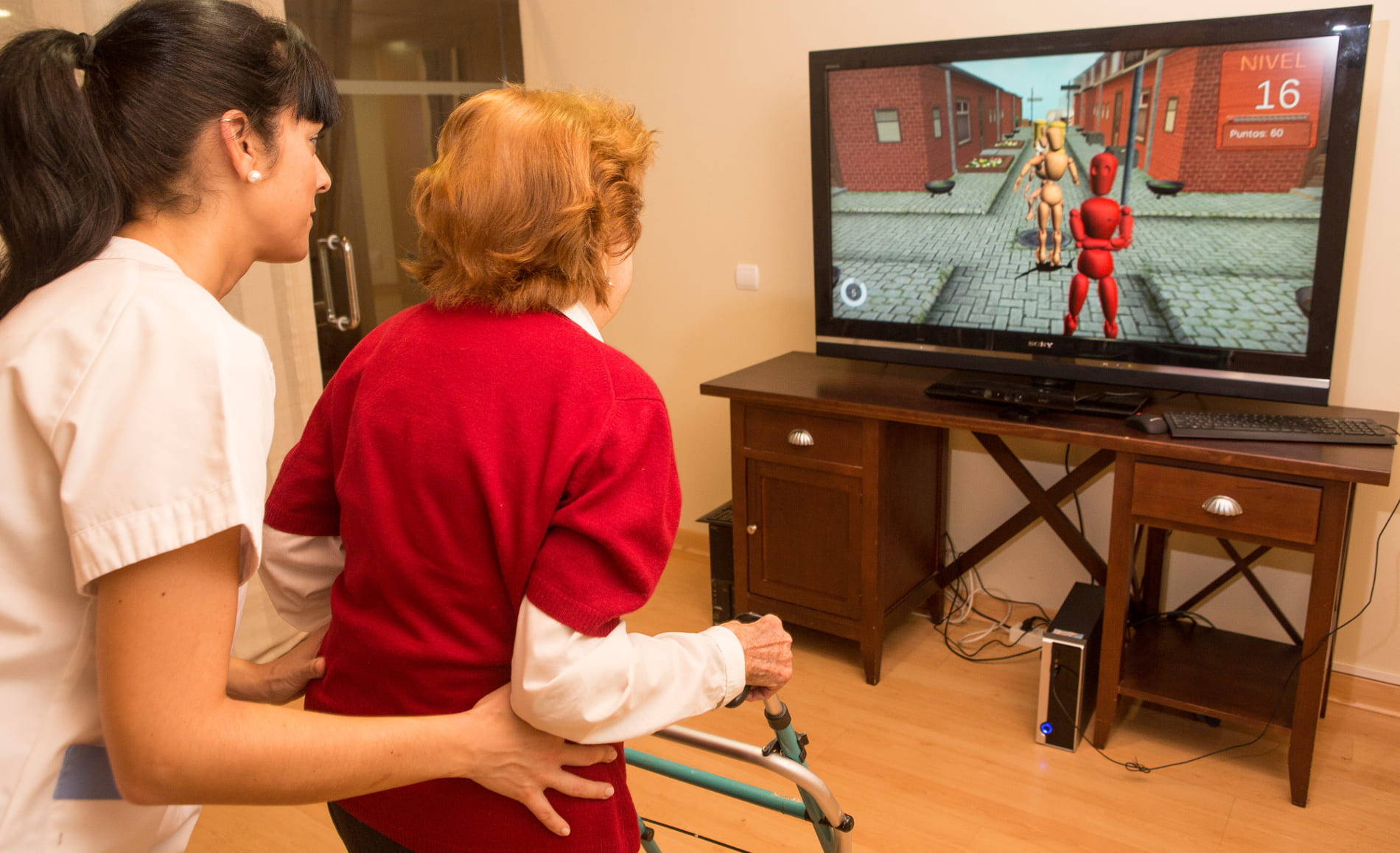
Rehametrics is a VR system that uses the infrared camera of Microsoft Kinect for move recognition. This platform can be used for clinical and at-dwelling house utilise to care for different physical and cerebral impairments.
Rehametrics allows to railroad train in the form of a game or do functional exercises in a virtual gym. With Rehametrics, people can railroad train static balance skills , endurance, unipodal balance, trunk control, and more. The uniqueness of this system is in its flexibility and possibility to adapt to individual treatment plans — an teacher or a doctor can adjust the range of bachelor exercises individually for each patient.
VR in Mail service-Trauma Rehabilitation
People who suffer from pain and motion limitations afterwards serious injuries at present accept a chance to rehabilitate with a side by side-gen 3D system CAREN .
This truly revolutionary, biomechanical VR organisation is designed for the rehabilitation of military personnel and athletes who have been seriously injured to help restore walking, posture and balance, and motor command, too as recover from back pain caused by different injuries.
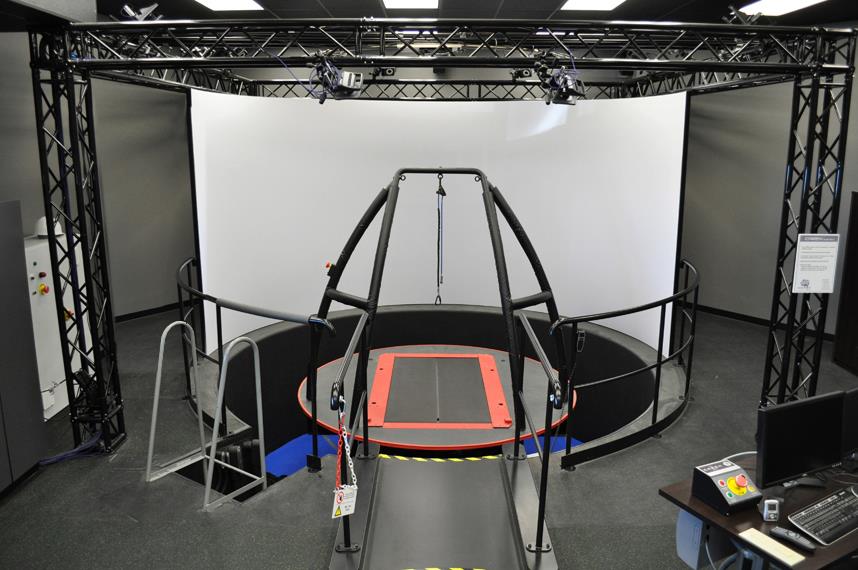
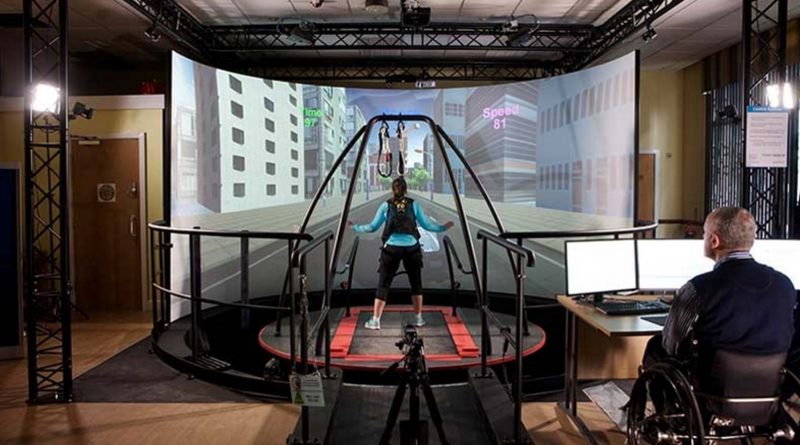
Both hardware and software components, including a motion base of operations, motion capture, a projection screen, and the D-flow software are used past most avant-garde research centers and clinics to train and clarify unlike motor functions of patients. CAREN offers three default modes that can exist modified further, depending on the specific needs and goals of patients in recovery.
VR in Rehabilitation of Patients with Mail service-Traumatic Stress Disorder
Immersion in virtual reality is one of the most constructive ways to fight a mail-traumatic syndrome disorder natural to militaries who experienced a traumatic stupor during the hostilities. Some hospitals and military machine bases in the United states of america utilise virtual reality programs, in which state of war veterans with similar psychosomatic disorders are plunged in faux hot spots to become through emotional turmoil again, simply in a safe virtual environment. This therapy allows releasing patients from bad experiences.

Bravemind is a virtual reality exposure therapy arrangement used by hospitals and military bases to treat soldiers with mail service-traumatic stress. The BRAVEMIND VR Exposure Therapy software has significantly decreased combat-related PTSD symptoms. Information technology allows soldiers to go dorsum to hard memories, relive those moments again and over again, but from a safe environment, and, finally, cope with their problems once and for all.
Virtual or Conventional Rehabilitation: What'southward More than Effective?
The possibility of virtual reality in medicine can exist rightfully considered unlimited. The power of Virtual Reality is also used by architects to build hospitals of the future, where hospital wards and rooms, operating facilities and intensive care units, every bit well as comprehensive rehabilitation gyms and alternative therapies, are first tested in VR. As for the apply of VR technology in rehabilitation, we would like to note that virtual reality, similar any other high-tech method, has advantages and disadvantages in comparison to traditional methods of concrete rehabilitation.
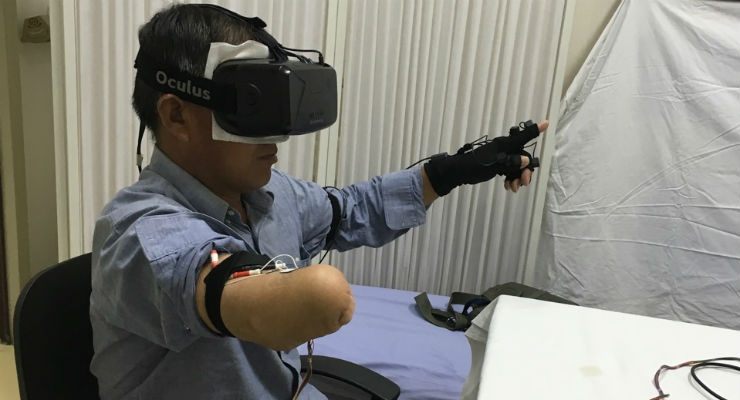
Ane of the obvious disadvantages of VR is the high price of the equipment and software required to achieve the effect of a total immersion into a virtual space. Just, despite some shortcomings, virtual reality has a number of undeniable advantages. The bulk of patients involved in VR therapy were much more motivated compared to traditional physical rehabilitation. While going through rehabilitation sessions in VR, patients could try on different roles and perform deportment hardly available to them in existent life. Rehabilitation procedures with the use of Virtual Reality applications amend the emotional state of patients, which, in turn, serves equally a farther positive factor on the road to recovery.
Information technology does non at all mean that virtual reality tin replace traditional rehabilitation methods—of course non. However, we believe that virtual reality will soon accept an important place in treatment and organically supplement conventional methods of rehabilitation.
Want to get more stories to your email?
DOWNLOAD HERE
Posted by: garciadereddeedly73.blogspot.com

0 Comments